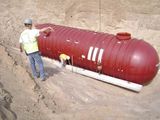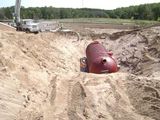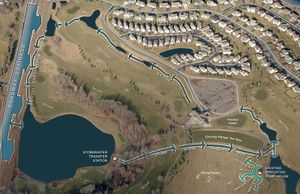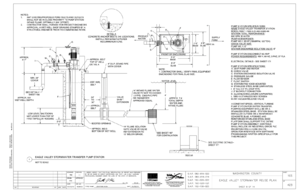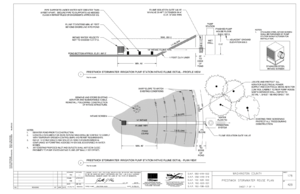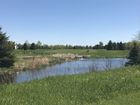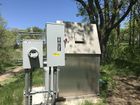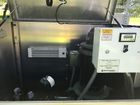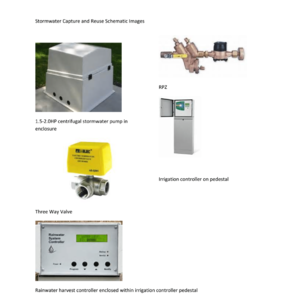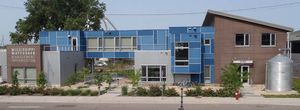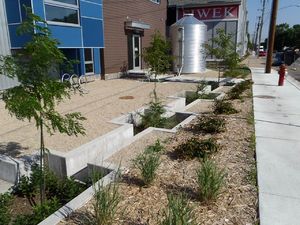
Case studies for stormwater and rainwater harvest and use/reuse
To see a database of reuse projects, link here.
Contents
Cottage Grove City Hall
- Location: Cottage Grove, MN
- Owner: City of Cottage Grove
- Designer: Wold Architects (City Hall), SkyHarvester (reuse system)
- Year of Completion: 2012
- Total Drainage Area: 0.9 acres of rooftop
- Total Construction Cost: $120,000
- Pretreatment/Methods of Filtration: Rainwater filter (screen to remove large particles leaves, debris, and sediment), Fine filter (filter fine particles, down to 5 microns), UV Treatment (provides microbial disinfection)
- Documented Maintenance Practices: Replacement of filter media and UV bulbs as needed, general winterization of irrigation system
- Pollutant Removal: Runoff volume control approximately 1.8 acre-feet (570,000 gallons) per year. MIDS calculator estimates pollutant reductions of approximately 1.5 pounds of phosphorus (0.85 pounds particulate phosphorus and 0.70 pounds dissolved phosphorus), and 282 pounds total suspended solids per year.
- Is the site publicly accessible: Yes, an interpretive sign is on the rear patio of City Hall for public viewing.
- Special Design Features: Rainwater Harvester Control Panel to regulate operation of systems, Irrigate planting beds on 7-acre site, education signage about system
In 2012 the City of Cottage Grove completed construction of the new City Hall and Public Safety complex, designed by Wold Architects. The building is situated in a growing part of the community, directly adjacent to Cottage Grove Ravine Regional Park, a natural resource and recreation amenity area which features unique habitat and a beloved fishing lake. In an effort to reduce water use and impacts on stormwater runoff, the building design incorporates a stormwater harvester system. The harvester reuses stormwater collected from the building's roof for irrigation of the green space around the building and the Veterans Memorial fountain located at the building entrance. This system collects runoff from the 0.9 acre roof and stores it in an underground storage tank. From the storage tank, the water is filtered and treated with ultraviolet light then pumped through the irrigation system for use on the 7-acre City Hall grounds, and at the fountain. The purpose of the system is to provide the dual benefits of reducing the use of groundwater for landscape irrigation and minimizing stormwater runoff to Ravine Lake.
- Click on an image for enlarged view.
Eagle Valley and Prestwick Golf Club, Woodbury
- Location: Woodbury, MN
- Owner: City of Woodbury/Prestwick Golf Club Inc
- Designer: HR Green, Water in Motion
- Year of Completion: 2014
- Design Features:
- Eagle Valley - large storage pond and babbling brook landscape feature for holding and moving stormwater runoff and reuse
- Prestwick – creation of one large storage pond from two smaller ponds for holding and moving stormwater runoff for irrigation reuse
- Total Drainage Area: 430 acres (Eagle Valley), 130 acres (Prestwick)
- Total Construction Cost: $700,000.00 (funding from South Washington Watershed District/Clean Water Fund)
- Pretreatment: screen filter on intake pump
- Documented Maintenance Practices: winterize irrigation system each year, clean pump screen if it gets clogged (has not been needed during first three years of operation)
- Pollutant Removal: 99 lbs phosphorus per year, and 9.6 Acre/ft per event volume reduction
- Is the site publicly accessible: Yes
- Project Background
In 2014, the City of Woodbury, with funding from the South Washington Watershed District, constructed stormwater reuse for irrigation systems at Eagle Valley and Prestwick golf clubs. Each system collects runoff from a large drainage area containing roads, housing developments, and a golf course and stores it in a centralized pond. A pump then draws water from the pond for use in golf course irrigation. The total cost of both projects was $700,000.00. The catalyst for the projects was the planned reconstruction of CSAH 19 (Woodbury Drive), changing it from a rural 2-lane road to an urban 4-lane road. The goals for the project were to have no measurable downstream stormwater impacts from the road reconstruction project, and to help achieve Colby Lake’s target TMDL standard to reduce phosphorus (TP) inputs by 30 lbs per year.
- Eagle Valley Golf Course
Prior to the reuse for irrigation project Eagle Valley Golf Course pumped 30 million gallons of well water annually to irrigate approximately 60 acres of golf course turf and landscaping. This project collects stormwater runoff from a 430 acre drainage area covering the golf course, surrounding neighborhoods, and Woodbury Drive into a storage pond on the course. The drainage area is 33.8% impervious. The reuse system can pump approximately 22.5 million gallons of stormwater for irrigation from the pond annually. The remainder of irrigation water that is needed will be supplied by the existing well. Stored water can also be routed through a babbling brook landscape feature on the golf course. The P8 modeled water quality benefits of the project at Eagle Valley were reductions in TP to Colby Lake of 56 lbs per year, and a volume reduction of 6.1 acre/ft per event.
- Prestwick Golf Club
Prestwick golf club regularly irrigates up to 75 acres of turf and landscaping. Previously, course managers pumped 35 million gallons of water annually from a course well to accomplish this. The stormwater reuse system which was installed in 2014 can now supply approximately 17.5 million gallons of water from the storage pond annually. The 130 acre drainage area for the pond is 27% impervious. The remainder of irrigation water that is needed will be supplied by the existing well. The P8 modeled water quality benefits of the project at Prestwick were reductions in TP of 43 lbs per year, and a volume reduction of 3.5 acre/ft per event.
- Conclusion
The City of Woodbury far exceeded their goals for water quality and volume reduction with the implementation of these two reuse projects at Prestwick and Eagle Valley. In total the projects reduce TP loading to local lakes by almost 100 lbs per year, and also reduces volume by 9.6 acre/ft for each event. The goals were 35 lbs of TP per year, and 1.84 acre/feet per event. In addition, both projects combine to reduce pumping from local aquifers by 40 million gallons annually by utilizing surface storage features (ponds) that add beauty and challenge to both golf courses.
- Click on an image for enlarged view.
Carver County Club West Development
- Location: Harvest Estates, Chaska, MN
- Project Owner: Club West Partners LLC
- Project Designer: Alliant Engineering
- Year of Completion: 2015
- Design Features:
- Gallons used for irrigation annually: Permitted for 22.2 million gallons
- Use for water: Irrigation of Lawn in Park, Boulevard Plantings and Flower Beds
- Rainwater Harvester Control Panel: Regulates operation of irrigation systems
- Total Drainage Area:
- Pond 1 = 28 acres
- Pond 3 = 25 acres
- Drainage Area Surface Type: Residential (roads, driveways, turf, etc.)
- Pond Size:
- Pond 1 = 18,600 sq ft
- Pond 3 = 22,413 sq ft Irrigated area
- Pond 1: 30,807 square feet
- Pond 3: 42,267 square feet
- Cost Savings Per Year: $3,000 on irrigation water (compared to City potable water rates)
- Pretreatment: NURP pond and screen filter in intake pump
- Methods of Filtration: Filter Screens
- Documented Maintenance Practices: winterize irrigation system each year, clean clogged pump screen (annual startups and blow outs)
- Pollutant Removal: 4.37 lb TP and 1,503 lb TSS per year
- Is the site publicly accessible? Yes - Park and boulevards are central features to the neighborhood. With the systems in close proximity to the neighborhood and park entrances, awareness of the system is heightened.
Club West Partners, the developer of Harvest Estates, worked with the Carver County Watershed Management Organization (CCWMO) to implement a stormwater harvest and use system that would meet stormwater, TP, and TSS reduction requirements (90% TSS and TP reduction, per CCWMO rules) for that subwatershed. Designed by Alliant Engineering, the harvest and use project utilizes stormwater runoff draining from a new development, Harvest Estates, for irrigation of common areas within the development. The site is located in southwest Chaska, MN, in close proximity to the Minnesota River, where population growth trends continue to encroach on undeveloped areas of the watershed. This project is one of five sites in Carver County where stormwater is being used to irrigate green space in order to mitigate the impacts of population growth on groundwater withdrawals.
At Harvest Estates, stormwater is collected into three stormwater ponds. Two intake pumps draw the stormwater from two of the three ponds to irrigate a central park and boulevard at the entrance of the development. By incorporating the harvest and use system into the construction of the new development, overall stormwater runoff impacts are partially mitigated and use of potable water for irrigation is reduced. Up to 22.2 million gallons of harvested stormwater can be used to irrigate the park and boulevards. The project goal is to harvest and use up to 12,500 cubic feet of stormwater per week, or equivalent to a depth of ½”of stormwater over the surface area of the new impervious paving in the development (18.8 acres total). The harvest and use system uses a 1.5-2.0 HP centrifugal stormwater pump, which is then transferred and managed through irrigation controller pedestals that allow for the efficient harvest and use of stormwater. The system reduces the need to pump irrigation water from conventional sources, with a bypass switch for municipal water only in cases of decreased rainfall. Harvested stormwater pumped from the two ponds goes through a filter system to remove sediment prior to irrigation uses. The modeled water quality benefits of the project are TP reductions up to 4.37 lb per year and TSS reductions up to 1,503 lb per year. To date, roughly 1.5 million gallons of stormwater have irrigated the site through the harvest and use system, with an overall cost savings of $3,000 each year due to the decreased use of potable water.
- Click on an image for enlarged view.
Mississippi Watershed Management Organization (MWMO)
Name of Project: Mississippi Watershed Management Organization (MWMO)
Type of Reuse System: Cistern
Overview: The cistern, located at the MWMO, utilizes rooftop runoff from the main office area roof to water trees in a trench system.
Location: Mississippi Watershed Management Organization, 2522 Marshall Street NE, Minneapolis 55418
Owners: Mississippi Watershed Management Organization
Contractors: Meisinger Construction-general contractor for facility construction
Operators: Mississippi Watershed Management Organization
Cost (additional plumbing would be needed if plumbed into the building to be used as grey water):
- Concrete Slab - $5,200
- Cistern (including piping) – $23,700
- Rain Leader- $8,400
Type and size of system: 4,000 gallon capacity CorGal Water Tank, volume annual dependent on rainfall, filled by roof runoff only
Year of Completion: 2012
Drivers/Stormwater Goals: To water trees, reduce stormwater runoff that reaches the river, infiltrate rainwater. Future use as grey water in facility.
Funding sources: Public – MWMO funding
Monitoring: Total Suspended Solids, VSS, bacteria, once every 3 months
Web links: http://mwmo.org/
Lessons Learned: Design flaws – the plumbing was not correct and all the water drained out, the rain leader diverter operation was not intuitive. Additionally plumbing code hindered process of connecting to facility to be used as grey water. Staff opted to do this at a later time once plumbing codes were updated and other projects set precedence.
For more information contact:
- Doug Snyder, Mississippi Watershed Management Organization Executive Director
- E-mail: Dnsyder@mwmo.org
- Phone: 612-746-4971
Links to Other Case Studies in Minnesota
Below are Minnesota examples of outdoor and indoor reuse systems.
Outdoor use
- The City of St. Anthony Village water reuse facility collects stormwater runoff from a county road, city hall, local streets and backwash water from the City's water treatment plant in a half million gallon reservoir located underground. Water stored in the reservoir is recycled to irrigate a 20 acre site that includes a municipal park and St. Anthony's City Hall campus. For more information, watch the City of St. Anthony video or go to the Mississippi Watershed Management Organization's web site.
- The Oneka Ridge Golf Course project in the City of Hugo, collects and stores stormwater runoff from nearly 1,000 acres of land upstream of Bald Eagle Lake and uses it, instead of pumped groundwater, to irrigate 116 acres with the golf course. For more information, go to the Rice Creek Watershed District web page
- Target Field, home of the Minnesota Twins, collects stormwater in a 200,000 gallon cistern. This water is treated and used to irrigate the ball field, reducing city water use by 2 millions gallons per year. Read Greening the Ballpark for more information.
- The Eagle Valley and Prestwick Golf Courses in Woodbury are installing two large scale water re-use systems that will capture urban runoff and excess nutrients that would otherwise flow into Colby and Bailey Lakes and use it for irrigation. This project was funded in 2013 with a Clean Water Fund grant. The City of Woodbury has additional reuse and irrigation projects in the city-Windwood Park, Bielenberg Sports Center, Views at City Walk, Bielenberg Gardens and St. Therese. For more information on these projects, contact Sharon Doucette, Environmental Resources Coordinator at sdoucette@ci.woodbury.mn.us
- The Minnesota National Guard Facility in Arden Hills has an extensive water-collection system that stores rainwater in a 25,000-gallon underground cistern for reuse in wash bays with a second 20,000-gallon tank to filter rainwater for irrigation.
- Maplewood Mall has a 5,700 gallon cistern that catches roof runoff.
- Carver County has five sites where stormwater is being to irrigate balllfields and turf. They are Beise Addition, Chevalle, Club West, Copper Hills and Waconia School District. Carver County Watershed Management Organization also has stormwater Reuse Guidelines.
- The City of Cottage Grove installed a rainwater harvesting system that captures, stores and cleans City Hall rooftop runoff, which is then used to irrigate planting areas throughout the site. The system reduces the City's annual water usage by 570,000 gallons. This project was partially funded with a grant from the South Washington Watershed District. For more information, contact Jennifer Levit, City of Cottage Grove at jlevitt@cottage-grove.org
- The City of Lakeville has a stormwater pond irrigation system located in King Park. The project was completed cooperatively by the City of Lakeville and the Vermillion River Watershed Joint Powers Organization.
- Edison High School in Northeast Minneapolis will be irrigating the athletic field using stormwater runoff from the gymnasium roof and new plaza. For more information, go to the Mississippi Watershed Management Organization's web site.
- The City of Roseville and the Capitol Region Watershed District are constructing a project to treat stormwater and store it for use as irrigation at the softball field at Upper Villa Park.
- File:New Hope Rainwater Harvesting and Water Quality System Sign High Res.pdf
Indoor use
- The City of St. Paul's Lowertown Ball Park (CHS Field) is using rainwater for toilet flushing and for irrigation of the ballpark. The cistern was installed in February, 2015 and is now operational. For more information, contact Wes Saunders-Pearce/Water Resources Coordinator at 651- 266-9112 or Wes.Saunders-Pearce@ci.stpaul.mn.us. Information about the project (including an informative video) is available at the Metropolitan Council's web site .
- Great River Energy in Maple Grove: Rainwater from the rooftop is collected in a 20,000-gallon cistern, treated with ultraviolet light, and used for toilet and urinal flushing.
- The new Target Field Station (The Interchange) features the first-ever, year-round snowmelt and stormwater runoff capture and reuse system in Minnesota. Snowmelt or stormwater is collected in cisterns and then pumped to the Hennepin Energy Recovery Center (HERC), a nearby waste-to-energy facility that burns municipal waste to generate energy. The HERC facility uses the water in a variety of industrial processes, thereby reducing the facility's dependence on the municipal water supply. In total, the stormwater system will direct approximately 1 million gallons of stormwater runoff per year toward the HERC facility for reuse. For more information, go to the Mississippi Watershed Management Organization's web site.
- The City of Shoreview's maintenance facility captures rain water runoff from the roof in an underground tank that is used for toilet flushing and vehicle washing. For more information contact Mark Maloney at the City of Shoreview: mmaloney@shoreviewmn.gov
- The University of Minnesota's 17th Avenue Residence Hall is collecting rainwater from the roof, holding it in a 35,000 gallon cistern and using the water to flush 200 toilets. For more details about this project, visit the Metropolitan Council's web site.
- Schaar's Bluff Gathering Center in Dakota County utilizes rainwater harvesting for toilet flushing.
Related pages
- Overview for stormwater and rainwater harvest and use/reuse
- Design criteria for stormwater and rainwater harvest and use/reuse
- Construction specifications for stormwater and rainwater harvest and use/reuse
- Operation and maintenance for stormwater and rainwater harvest and use/reuse
- Water quality considerations for stormwater and rainwater harvest and use/reuse
- Environmental concerns for stormwater and rainwater harvest and use/reuse
- Cost-benefit considerations for stormwater and rainwater harvest and use/reuse
- Case studies for stormwater and rainwater harvest and use/reuse
- Calculating credits for stormwater and rainwater harvest and use/reuse
- Definitions for stormwater and rainwater harvest and use/reuse
- Requirements, recommendations and information for using Harvest and re-use/cistern as a BMP in the MIDS calculator
- Links for stormwater and rainwater harvest and use/reuse
- References for stormwater and rainwater harvest and use/reuse
- Technical support for stormwater and rainwater harvest and use/reuse
This page was last edited on 29 December 2022, at 01:16.



